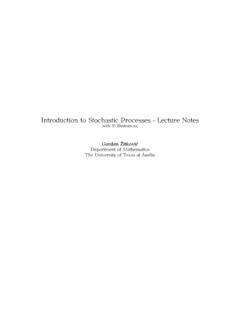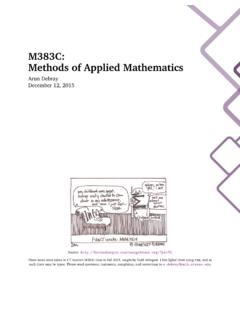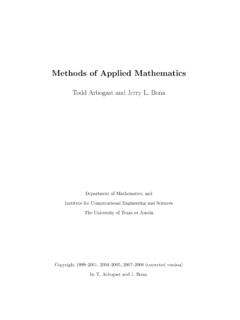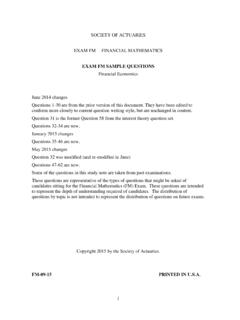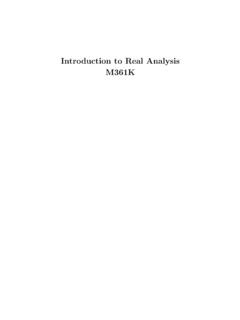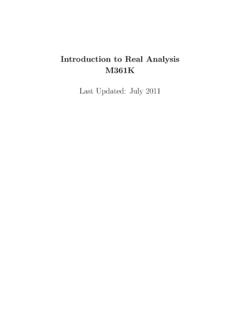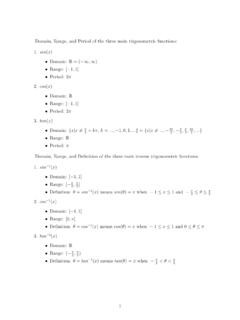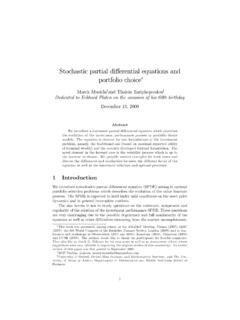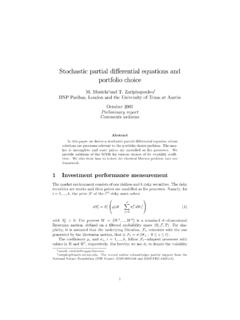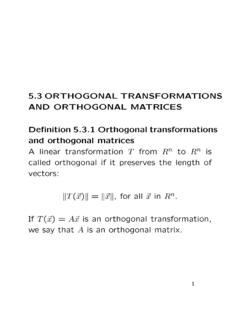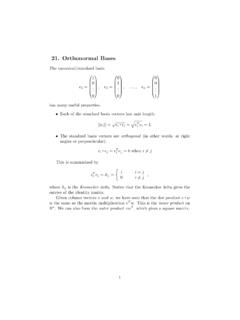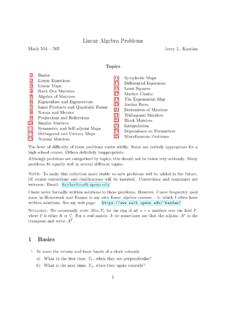Transcription of Linear Transformation Exercises
1 Linear Transformation ExercisesOlena BormashenkoDecember 12, 20111. Determine whether the following functions are Linear transformations. Ifthey are, prove it; if not, provide a counterexample to one of the properties:(a)T:R2 R2, withT[xy]=[x+yy]Solution:ThisISa Linear Transformation . Let s check the properties:(1)T(~x+~y) =T(~x) +T(~y): Let~xand~ybe vectors inR2. Then,we can write them as~x=[x1x2], ~y=[y1y2]By definition, we have thatT(~x+~y) =T[x1+y1x2+y2]=[x1+y1+x2+y2x2+y2]andT(~x ) +T(~y) =T[x1x2]+T[y1y2]=[x1+x2x2]+[y1+y2y2]=[x1 +x2+y1+y2x2+y2]Thus, we see thatT(~x+~y) =T(~x) +T(~y), so this property holds.(2)T(c~x) =cT(~x): Let~xbe as above, and letcbe a scalar.
2 Then,T(c~x) =T[cx1cx2]=[cx1+cx2cx2]whilecT(~x) =c[x1+x2x2]=[cx1+cx2cx2]Therefore,T(c~x) =cT(~x), so this property holds as (b)T:R2 R2, withT[xy]=[x2y2]Solution:This isNOTa Linear Transformation . It can be checked that nei-ther property (1) nor property (2) from above hold. Let s show thatproperty (2) doesn t hold. Let~x=[11]and letc= 2. Then,T(~x) =T[11]=[11]and therefore, we have that2T(~x) =[22]However, we haveT(2~x) =T[22]=[44]Thus, we see that 2T(~x)6=T(2~x), and henceTis not a Linear trans-formation.(c) Fix anm nmatrixA. Then, letT:Mlm Mln, withT(B) =BASolution:ThisISa Linear Transformation . Let s check the properties:(1)T(B+C) =T(B) +T(C): By definition, we have thatT(B+C) = (B+C)A=BA+CAsince matrix multiplication distributes.
3 Also, we have thatT(B) +T(C) =BA+CAby definition. Thus, we see thatT(B+C) =T(B) +T(C), sothis property holds.(2)T(dB) =dT(B): By definition,T(dB) = (dB)A=dBAwhiledT(B) =dBATherefore,T(dB) =dT(B), so this property holds as (d) LetVbe the vector space of functions fromRtoR, under normalfunction addition and scalar multiplication. Then, letT:V R2,withT(f) =[f(0)f(1) + 1]Solution:This isNOTa Linear Transformation . Neither property (1) norproperty (2) hold. Let s show that property (1) doesn t hold. Letfandgbe functions inVsuch thatf(x) = 1,g(x) =x. Then, wehave that(f+g)(x) =x+ 1 Therefore, we see thatT(f) +T(g) =[12]+[02]=[14]whileT(f+g) =[13]Thus,T(f) +T(g)6=T(f+g), and thereforeTis not a Linear For the following Linear transformationsT:Rn Rn, find a matrixAsuch thatT(~x) =A~xfor all~x Rn.
4 (a)T:R2 R3,T[xy]= x y3y4x+ 5y Solution:To figure out the matrix for a Linear Transformation fromRn, wefind the matrixAwhose first column isT(~e1), whose second columnisT(~e2) in general, whoseith column isT(~ei). Here, by definitionwe have thatT(~e1) =T[10]= 104 , T(~e2) =T[01]= 135 Thus,A= 1 10345 3(b)T:R2 R2, satisfyingT[11]=[1 2], T[23]=[ 25]Solution:We need to findT(~e2) andT(~e2). Given the information we have,this is easiest to do by writing~e1and~e2as Linear combinations of{[11],[23]}We start with~e1. We solve[10]=c1[11]+c2[23]Setting up the system of equations as usual and solving yieldsc1=3, c2= 1. Thus, we have that[10]= 3[11]+ ( 1)[23]Now, sinceT(~x+~y) =T(~x) +T(~y), andT(c~x) =cT(~x), this gets usthatT[10]=T(3[11]+ ( 1)[23])=T(3[11])+T(( 1)[23])= 3T[11]+ ( 1)T[23]= 3[1 2]+ ( 1)[ 25]=[5 11]Similarly, we get that[01]= ( 2)[11]+[23]and a calculation like the one above yieldsT[01]= ( 2)T[11]+T[23]= ( 2)[1 2]+[ 25]=[ 49]Combining the information, we see thatA=[5 4 119]4(c)T:R2 R2, whereT(~x) is~xrotated by 30 :Again, we need to figure outT(~e1) andT(~e2).
5 Basic trigonometryshows thatT(~e1) =T[10]=[ 3/2 1/2]T(~e1) =T[01]=[1/2 3/2]Thus,A=[ 3/21/2 1/2 3/2]5
